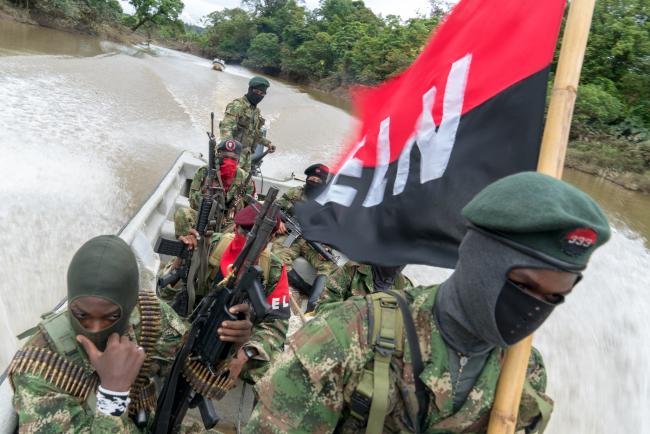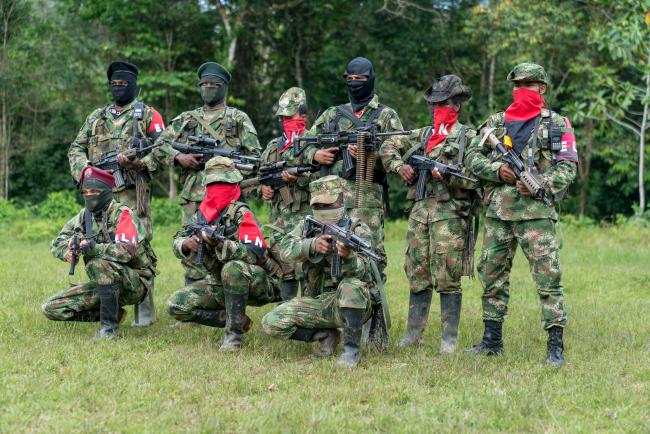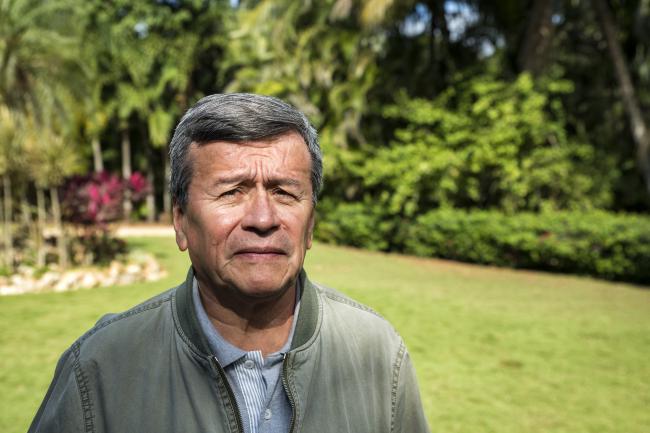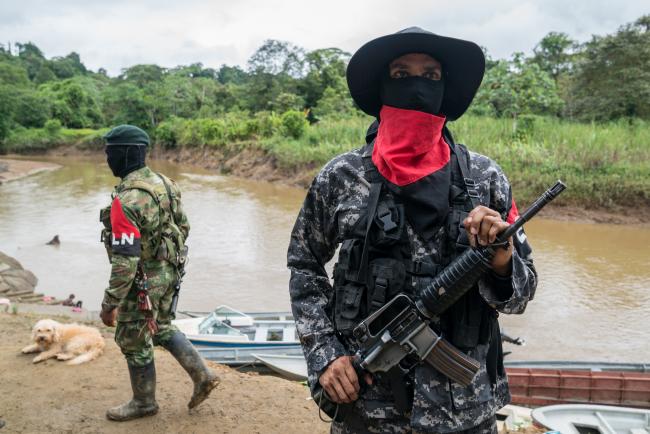
This December, we are asking readers to make a tax-deductible contribution before the year is over to ensure NACLA continues to provide only the best in progressive news and analysis on Latin America. Visit nacla.org/donate
It’s been called Colombia’s “other war,” and it is certainly proving the most persistent. On December 9, four trucks and two buses were detained at a makeshift roadblock on the road that connects the city of Medellín with the Caribbean coast. Men in camouflage began to set the vehicles alight as the drivers and passengers fled to safety. The army arrived and a gun battle ensued. Witnesses described the distinctive armbands of the assailants: red and black, marked with the letters “E-L-N” in white.
Attacks like these on transport and infrastructure are their bread and butter of the ELN, the Spanish acronym for the National Liberation Army. The ELN is Colombia’s largest remaining leftist guerrilla group after the demobilization of the FARC, and its insurgency constitutes one of the longest rebellions in history. After more than 55 years of belligerence, which has claimed more than 10,000 civilian victims of murder, kidnapping, and other crimes, the ELN does not represent a national insurgent threat, but it can and does wreak havoc on the vulnerable margins of Colombia.
This latest attack came just hours after the government had signalled it could be willing to return to the negotiating table with the ELN. The government suspended peace talks indefinitely in January 2019 after a car bomb attributed to the ELN killed 22 people and injured more than 60 at a school for police cadets in Bogotá. President Iván Duque has since made clear that the ELN must meet certain conditions before talks can resume, including releasing all hostages and ceasing violent acts.
So far, the ELN has refused to meet these demands, but the insurgents insist they are committed to peace and willing to return to negotiations. But this contradictory approach—defined best by former President Juan Manuel Santos as “words of peace and actions of war”—creates high levels of distrust. Indeed, for many Colombians, the ELN remains a mystery.
The ELN’s intricate structure is perplexing to outsiders, but understanding how the insurgency operates and the dominant currents within the guerrilla leadership can shed light on the potential for negotiations and ultimately on the chances for peace. Over the past two years, I have spent several weeks embedded with the guerrilla in both western and eastern Colombia and have interviewed over 100 combatants and ex-combatants, including founding members of the insurgency.
The ELN prides itself on being a unified force, but its unity is founded in diversity. The contemporary ELN can be characterized by three distinct perspectives. There are those who support a return to negotiations and for whom peace has become the ultimate goal of the insurgency (the pragmatists); those who see the government as an enemy to be defeated and for whom peace is seen through the prism of a victory over capitalism (the hardliners); and a small, but increasing number of commanders, for whom peace is neither profitable nor an ambition because they are only interested in the gains from their participation in illicit economies (the profiteers).
These diverse views create intense debate among the insurgents. The complex structure of the ELN and its even more complex and federalized decision-making processes allow for much disagreement and discussion. But there are increasing signs—despite their denial to the contrary—of fundamental divisions over both strategy and ideology that may be creating definitive factions as a result of these differences.
Importantly, the ELN insurgency is on the verge of a generational shift in its leadership. While veteran commanders exhibit a moderate, if cautious temperament, the younger generations generally embody a more rigid and uncompromising approach. This transition will undoubtedly bring tectonic change and is why the next decade could provide what might be the last significant opportunity for peace.
Origins, Structure, and Organization
Marxist intellectuals inspired by the Cuban Revolution founded the ELN in 1964. Radical Catholic priests subscribed to liberation theology later joined their cause.
The guerrilla’s logo is a hammer and machete crossed over South America; its motto, “Not one step back: Liberation or death.” In the last four years, as the revolution has become increasingly tainted by the lure of the international drugs trade and other illicit economies, they have certainly been moving forward with an exponential growth.
Since the 2017 demobilization of their guerrilla rivals, the FARC, the ELN has sought to move in on communities and economies once under FARC control. The ELN is now present in 156 municipalities, compared to 96 in 2016, and boasts a force of 2,402 insurgents, according to Colombian military intelligence.

The ELN has also expanded into Venezuela, which became a safe haven for the Colombian guerrilla when Hugo Chávez came to power in 2002. But today it is much more than a sanctuary. Under Nicolás Maduro, Venezuela provides access to fruitful trafficking networks in drugs, gold, and fuel. The insurgents have also begun to exert social control over many Venezuelan communities. According to Insight Crime, the ELN has a presence in 12 of Venezuela’s 24 states.
The ELN is ruled by a National Congress, which since 1987 has met roughly every 10 years. The congress is made up of the Central Command and the Directorate, which manage the day to day running of the insurgency. In 2014, at its fifth congress, the ELN voted in favour of discussions with the government, but it also voted to prepare for both war and peace to accommodate conflicting interests within the organization. These differences continue to cause rifts today.
The Central Command, known by its Spanish acronym COCE, historically has consisted of five members and leads the ELN most of the time. The Directorate is much larger with 20 commanders, comprising the Central Command and representatives from the various regional units. This allows local commanders to have direct influence over the future of the organization. On paper, both of these bodies are equal, but the larger size of the Directorate makes it challenging to convene regularly. The opportunities for it to exercise genuine control are therefore rare.
Since 1986, the ELN has been divided into six regional war fronts, which are themselves divided into 29 rural fronts and 22 companies. There is also one national urban front, which operates in the main towns and cities, and a network of militias, which act as intelligence and infiltrate state institutions and civil organizations. Each unit carries out decisions with a high degree of autonomy. There are regular votes on all levels of the structure to allow for collective leadership and what the rebels call “centralized democracy.”
Such sophisticated structures and processes mean achieving peace with the ELN is going to be difficult. Perhaps the insurgency’s biggest challenge is not signing a deal with the government, but rather striking agreement between themselves.
The Pragmatists
The pragmatists are led by 65-year-old Israel Ramírez Pineda, best known by his alias, Pablo Beltrán. He leads political strategy within the Central Command. In an interview last February, he told me the ELN’s primary objective was to end the conflict. “People are tired of war, including us,” he said.
Mild-mannered Beltrán wears a permanent grin, but it’s not sarcastic. He has a subtle, but genuine charisma. He admitted that the ELN’s ambitions are far less sweeping today than they have been historically. “We’re no longer asking for socialism. We’re no longer planning to overthrow the government. We want to lay down our arms and ensure social transformation for the poorest,” he told me from exile in Cuba.
Beltrán’s outlook is shared by the ELN’s military chief, 63-year-old Eliecer Erlinto Chamorro, alias Antonio Garcia. He’s known by many as “the Grey Man.” For more than 30 years, this pair have dominated the Central Command.
The pragmatists know they have a hard sell to the rank and file. For example, it is difficult to see what this “social transformation” Beltrán mentioned might constitute. Rebels on the ground, for example, say they continue to protect marginalized communities from resurgent drug gangs and multinational developers. But it is difficult to imagine that the government will be able to stem the illegal drug trade or refuse international investment in its economy in order to appease the ELN.
Combined with the failures of the peace process with the FARC, this puts the ELN leadership in a difficult position when it comes to convincing their comrades to abandon their weapons. This is why the leadership has already made clear that their troops will not demobilize until whatever peace agreement is achieved is fully implemented.

Despite the huge respect they command from their subordinates, there is no doubt that the pragmatists are increasingly isolated from the grassroots rebels. Although there is regular communication between the Central Command and the regional war fronts, there is a growing perception that the leadership—most of whom are firmly settled in Havana awaiting the resumption of peace talks—have become distanced from the reality on the ground. Since the 1980s, the Central Command had their own jungle base. They could rely on legions of loyal and dedicated followers with whom they would share the day’s struggles and battles. For the past three years, however, they have been remote figures, and other charismatic leaders have been able to galvanize the foot soldiers in their place.
The Hardliners
The hardliners have few incentives to negotiate. They enjoy significant local power, and they have begun to boost their income and expand their territorial reach. The Eastern War Front in Arauca, for example, co-governs with local authorities, obstructing or permitting public works projects, as long as politicians and wealthy locals pay the group “taxes.” In Arauquita, they mark out their turf by daubing their initials on local houses. This graffiti is more than vandalism: It symbolizes a form of social control that extends through Colombia’s eastern plains and into Venezuela’s borderlands.
The hardliners, led by Gustavo Aníbal Giraldo, alias Pablito, have long been critical of the peace process. For the hardliners, an end to the conflict can only be brought about through victory, and not what they perceive to be surrender.
51-year-old Pablito leads the Eastern War Front. He is known for his ruthlessness and is often referred to as “the Tiger.” Pablito ordered last January’s bombing in Bogotá. It was seen as a deliberate attempt to derail the peace process, even if many within the ELN denied it.
Pablito, who joined the ELN as a 15-year-old in the early 1980s, personifies the opposition to Pablo Beltrán and Antonio Garcia. Beltrán and Garcia attempted to bring him into the fold in 2014 by allowing him to join the Central Command, but it appears their tactics failed. This is perhaps in part because there is also an apparent bitter personal rivalry between Pablito and Garcia, who share responsibility for military strategy. Pablito has publicly accused Garcia of involvement in his 2007 arrest by the army. Pablito spent two years in prison before an elite ELN unit broke him out in very dramatic fashion. Authorities now believe he is hiding out in Venezuela, from where he directs extortion rackets, drug trafficking, and regular attacks on oil pipelines and the security forces.
The Profiteers
Drugs are a thorny issue inside the ELN. There is little doubt that the insurgents have increasingly progressed from charging taxes on traffickers moving drugs through their territory to directly participating in the production and trafficking of cocaine and heroin.
Despite an internal prohibition on involvement in the illegal drugs trade, demobilized rebels say producing and shipping drugs became a necessary evil to fund the guerrilla insurgency. They estimate 90 percent of the ELN’s earnings come from the production and supply of cocaine, while the rest reportedly comes from mining and extortion.
In the Nariño department in southern Colombia, the ELN’s efforts to expand are directly related to its attempt to gain control of drug trafficking routes, such as the Patía river and the towns of Llorente and La Guayacana. The group’s expansion in northeastern and western Colombia is also linked to its increased role in this illicit economy. Last year, the military said it had uncovered a cocaine laboratory belonging to the rebels in Catatumbo, near the Venezuelan border.

In 2017, authorities seized tons of cocaine apparently belonging to the ELN in Chocó, along the Pacific coast, where they also uncovered the first-ever electric semi-submersible, apparently also belonging to the ELN. It was a sophisticated vessel, built to ship tons of illegal merchandise underwater.
Two figures most associated with the ELN’s criminal activities are Oglí Ángel Padilla, alias Fabian, one of the commanders of the Western War Front, and Gabriel Yépez Mejía, alias HH, who operates in Nariño. Little is known about either man, but both have expressed criticism of the ELN’s pursuit of peace.
A Limited Window for Peace
The one man holding all this together is Nicolás Rodríguez Bautista, alias Gabino. Known as Colombia’s oldest insurgent, he joined the ELN in 1964 at the age of 14. He became the overall ELN commander just 10 years later after the majority of the ELN leadership was wiped out in an attack by government forces. Gabino has spent 55 of his 69 years in open rebellion. As a result, he is probably the ELN’s most revered commander and certainly the most unifying figure.
Although Gabino shares the view of the pragmatists, he is the calming influence of the Central Command and reportedly able to resolve tensions and discord. But Gabino is ill and apparently very weak.
Time is therefore running out for the pragmatists. Not only might they be losing ground with the rank and file, they are also growing older, and without the support of Gabino, they may quickly lose influence.
There is no doubt the current leadership wants to see an end to the conflict. But those coming up behind them are driven by a desire for victory—one that overturns capitalism—and by a criminal interest in power and profit. The danger, then, is that as the older moderates die, the chances for peace will pass with them.
The ELN is at an important crossroads. As the insurgents head towards their 11th congress in the next five years, they must decide on the course of action that will define them for the next decade. The moderates know this too, which is why they are desperate for a resumption of peace talks.
Sources tell me we may see some kind of gesture made by the ELN before Christmas—something that extends beyond their usual festive ceasefire. Even so, it would have to be something fundamental to persuade President Duque to return to the negotiating table in the new year. And whatever it is, it is certain to be seen as weakness and conciliatory by the hardliners, who will continue to wait patiently in the wings for their next move.
Mathew Charles is a post-doctoral researcher at the Colombian Organised Crime Observatory at El Rosario university in Bogotá. He is a former freelance foreign correspondent for The Telegraph and the BBC. He has reported extensively on Colombia’s internal armed conflict and its transition to peace.

